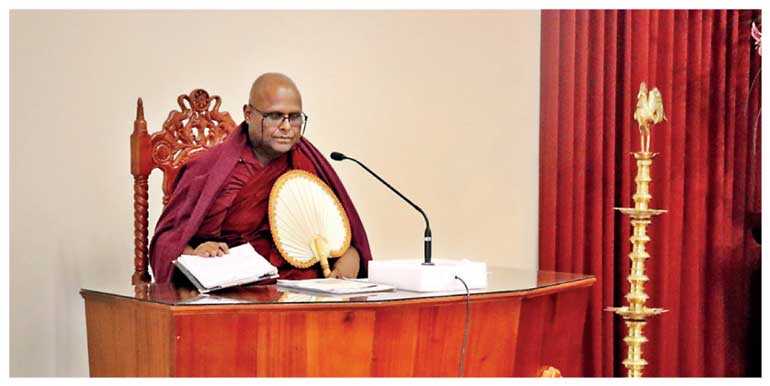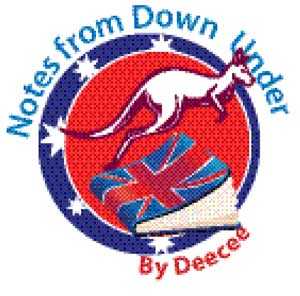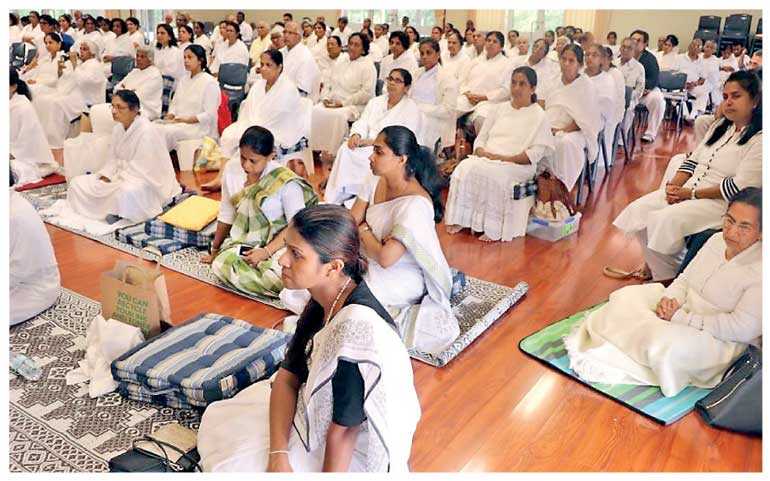Wednesday Apr 09, 2025
Wednesday Apr 09, 2025
Saturday, 23 March 2019 00:00 - - {{hitsCtrl.values.hits}}

Ven. Dhammagaveshi delivers a sermon on the Tripitaka
As the ‘Tripitabhivandana Week’ to mark the commencement of the process of declaring the Tripitaka – the essence of Theravada Buddhism – ends, the ceremony to formally announce the proposal made to UNESCO to declare the Tripitaka as a World Heritage will be held at the Maha Maluwa in the premises of the Dalada Maligawa today.
A national process has already been initiated to submit an application to UNESCO to inscribe the Tripitaka in the UNESCO ‘Memory of the World Register’. A technical committee has been appointed for this purpose.
With the declaration of the Tripitaka as a national heritage by President Maithripala Sirisena, now it has legal protection.
Last Sunday, at the Lankaramaya temple in Sydney on the initiative of the Sydney Sri Lanka Consulate General, the Chief Prelate Venerable Meegahakumbure Dhammagaveshi Nayaka Thera addressed the large gathering who had observed ‘sil’ on the significance of the Tripitaka. After tracing the history of the Tripitaka he spoke of the importance of inscribing Tripitaka in the UNESCO ‘Memory of the World Register’. A team for the Consulate General was present and at the conclusion of the sermon a brochure on the Tripitaka issued by the Presidential Secretariat was distributed.
 The Consulate General in Sydney also arranged a discussion with Ajahn Sujato of SuttaCentral.net and Dr. Mark Allon, Chair of School of Languages and Culture, University of Sydney recently on the Tripitaka. Consul General Lal Wickrematunge explained the significance of the event to the gathering.
The Consulate General in Sydney also arranged a discussion with Ajahn Sujato of SuttaCentral.net and Dr. Mark Allon, Chair of School of Languages and Culture, University of Sydney recently on the Tripitaka. Consul General Lal Wickrematunge explained the significance of the event to the gathering.
Sutta Central.net has been working on ensuring that the Tripitaka in the numerous languages (estimated as 30) are brought together and making them freely available.
Value
The value of the Tripitaka can be measured by the way renowned archaeologist Dr. Senerat Paranavitana described it: “The greatest contribution that the Sinhalese people had made to the intellectual heritage of mankind.”
Explaining why the Tripitaka was written down, scholar monk Venerable Walpola Rahula states that during the latter part of the 1st century BC the whole country was violently disturbed by a foreign invasion on one side and on the other it was ravaged by an unprecedented famine.
“The whole island was in chaos. Even the continuation of the oral tradition of the Tripitaka was gravely threatened. The far-seeing maha theras decided as a last resort to commit the Tripitaka to writing at Alu-vihara, so that the teaching of the Buddha might prevail,” he writes in his book ‘History of Buddhism in Ceylon’.
The historic event of writing the entire Tripitaka and the Commentaries (Atthakatha) took place during the reign of King Vattagamini Abhaya (29-17 BC). Five hundred monks led by Venerable Rakkhita undertook the task of writing the Tripitaka. They inscribed the words in the Pali language on ola (talipot palm) leaves – the traditional art of writing where the ola leaves are first dried and seasoned.

Gathering at the Lankaramaya
Discover Kapruka, the leading online shopping platform in Sri Lanka, where you can conveniently send Gifts and Flowers to your loved ones for any event including Valentine ’s Day. Explore a wide range of popular Shopping Categories on Kapruka, including Toys, Groceries, Electronics, Birthday Cakes, Fruits, Chocolates, Flower Bouquets, Clothing, Watches, Lingerie, Gift Sets and Jewellery. Also if you’re interested in selling with Kapruka, Partner Central by Kapruka is the best solution to start with. Moreover, through Kapruka Global Shop, you can also enjoy the convenience of purchasing products from renowned platforms like Amazon and eBay and have them delivered to Sri Lanka.
Discover Kapruka, the leading online shopping platform in Sri Lanka, where you can conveniently send Gifts and Flowers to your loved ones for any event including Valentine ’s Day. Explore a wide range of popular Shopping Categories on Kapruka, including Toys, Groceries, Electronics, Birthday Cakes, Fruits, Chocolates, Flower Bouquets, Clothing, Watches, Lingerie, Gift Sets and Jewellery. Also if you’re interested in selling with Kapruka, Partner Central by Kapruka is the best solution to start with. Moreover, through Kapruka Global Shop, you can also enjoy the convenience of purchasing products from renowned platforms like Amazon and eBay and have them delivered to Sri Lanka.